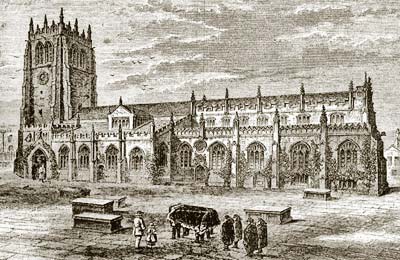History Society Report: Buried Alive? Past Funeral Customs in Calderdale
Speaker: David Glover
Wednesday, 19 October 2016

David Glover, local historian and writer, indulged our fascination with the macabre with his talk to Hebden Bridge Local History Society with an eclectic mix of tales of deaths and burials which can be found in local records and churchyards.
Buried alive
Being buried alive might be a recurrent nightmare, but there is at least one such recorded event in Halifax in 1770, when potential grave robbers were shocked to see the body of a certain Mary Haigh sit upright in the vault where she had recently been interred. Walking home to Shaw Hill in her grave clothes she must have been a terrifying sight, but was welcomed by her grieving husband and was even able to bear him another child in the years of life that followed.
Costs
Information about burials and funerals can be gleaned from various sources – parish records, churchwardens' reports, personal diaries, family archives and local and national newspapers. David looked at some of the costs entailed. It was more or less obligatory to be buried in the churchyard or church and in Medieval times, those who wanted to ensure quick progress through purgatory paid extra for prayers in the chantry chapels, for candles to be lit and for poor men to accompany the coffin. In later times an elaborate funeral was a statement of wealth with those in the business of despatching the dead doing good business with special mourning rings, clothes, gloves and scarves, as well as the funeral carriages and professional mourners or mutes that gave someone a special send off.
Consecrated ground burials
Those who were not buried in consecrated ground included suicides, who were often buried at crossroads. An area near People's Park once known as Goldsmiths Grave is thought to be one such location. Quakers could be buried in their own land, and Brighouse Quakers Jonathan Walsh and his wife did just that in 1823. These graves seem to have been lost until the vault was uncovered by quarrying in the area and the opportunistic Quarry company charged inquisitive locals 2d each to view the site. Victims of Halifax's gibbet seem to have been granted burial in church grounds, and the requirement for consecrated burial seems even to extend to body parts.
The records show that the amputated leg of Ambrose Patchett of Luddenden Dean was given a proper burial in 1883, followed by the burial of his body a year later.
Local Chartist
Graveyards themselves can provide much of historical interest which might stimulate research. A gravestone in Halifax mysteriously records that 'two were buried here by mistake'. Many cemeteries and churchyards have dedicated 'friends' who record the gravestone inscriptions and uncover the stories of those who were buried there. These include the story of Ben Rushton the famous local Chartist buried in Lister Lane, whose funeral was said to have been attended by 10,000 mourners, and the unusual Hindu burial of a travelling acrobat in Stoney Royd Cemetery in 1868.
Next talk
The next talk to Hebden Bridge Local History Society will be on Wednesday 26th October when members of the society will look at subjects including transport and woodland use from early days. Meetings are held at Hebden Bridge Methodist Church and start at 7.30. Details from www.hebdenbridgehistory.org.uk
You can also find details on the website of a special study day organised by Cragg Vale, Hebden Bridge and Mytholmroyd Local History Societies on Saturday 22nd October in support of the Flood Relief Fund. This will be held at the Methodist Hall in Hebden Bridge and will include talks, displays and guided walks.
With thanks to Sheila Graham for this report


